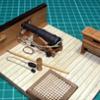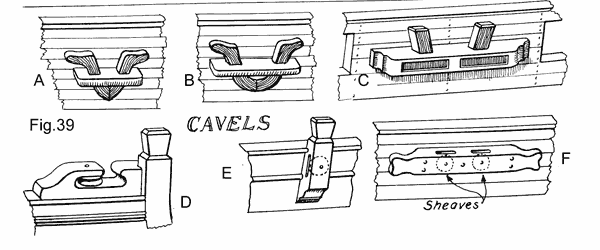-
Posts
5,938 -
Joined
-
Last visited
Content Type
Profiles
Forums
Gallery
Events
Everything posted by BANYAN
-
Thanks all, that is exactly the type of thing I am looking for. Much appreciate the feedback and great info. My real issue now is trying to interpret how the after-cant timbers will have differed as Victoria was built using Diagonal planking (to Oliver Lang's plan) whereby most of the frames (floors IAW the Contract) ended at the round of the hull. The usual frames were replaced with 'bent timbers' which replaced the temporary 'moulds'. These were placed midway between the floor timbers from the round to the gunwhale. When the side planking was put on, the first and second diagonals were actually wrapped under the hull and went up the other side, and the keel (except for 30 feet of it both forward, and aft) was put on after the diagonals and then the outer horizontal layer of planking put on in a more traditional manner once the bent and roughtree timbers had been put in. From what I can see, I believe I would need at least a 'full' aftermost cant-timber in-situ for the stern timbers to butt onto? Quite the puzzle for this model builder to get his head around cheers Pat
-
Hi all, I am trying to find some good examples of the timbers (fashion pieces, transoms etc) that would form a typical elliptical stern for a vessel c1855. I have looked through the NMM files (as best I can) for something that might be suited but have lucked out so far. I have also done a quick look (not yet complete) in the Danish Digital Library (Museum) and found a contemporary ship the Jylland, but she has a different arrangement. I have plans for the British Gun Despatch Vessels (Arrow Class 1854) and Vigilance Class (1856) but the plans do not show the framing or timbers. I would appreciate any pointers or suggestions that would allow me to create the framing/timbers used in such a vessel to allow me to draw up the 'probable' stern for HMCSS Victoria (1855). cheers Pat
-
I've never even seen a dado stack (blades) for that sized table Bruce - it will be interesting to see if anyone has. I typically use my router for these tasks - putting a sacrificial piece of wood behind the piece being cut/routed protects it from chip-out keeping it all nice and clean looking. I like your solution though, seems to work well. cheers Pat
-
Hi Steven, these could be the upper ends of the rising timbers but might also be the tops of cavels or the like - see attached which is from 'The Neophyte Ship Modeller's Jackstay'. Also, I agree these appear to be 'something' formed in loops as they appear to be draped over the timber tops rather than as a ring attached/fitted to the hull proper. Whether they are rope though I am not sure, as this is an unusual way to depict rope. cheers Pat
- 508 replies
-
No matter what the reason, great to see you back mate. I hope the recovery goes well. The revised stand looks good. cheers Pat
-
Wow that is some nice work 👋. I hope it all works for you, but I am sure testing may highlight a few small improvements or fixes to be made. She sure will look a 'picture' on the pond/pool. cheers Pat
- 536 replies
-
- Quadrireme
- radio
-
(and 1 more)
Tagged with:
-
Very nice work on such a delicate skeletal frame Steven. Not surprising you had to make a few corrections, but it all looks symmetrical and starting to look a little more robust. cheers Pat
- 508 replies
-
You're making some great progress there Steven. The 'skeletal' framework looks very delicate, so I hope the fitting of the clamps, breast kooks etc stiffen this up sufficiently for you when working the planking etc. cheers Pat
- 508 replies
-
Hi Glen, sorry have not commented much as I have been down and out with a flu of late - just getting back onto the horse so to speak. That is an incredibly well detailed miniature which will make into a very fine diorama; everything appears very nicely to scale. cheers Pat
- 290 replies
-
- Quinquereme
- Finished
-
(and 1 more)
Tagged with:
-
I think this is a case of 'horses for courses'. I find that the more pre-rigging of the tops and yards you do the easier you make it on yourself later - BUT some of these lines will need to be coiled and kept out of the way. More importantly, you need to be somewhat selective on which lines you pre-rig. This will depend on the ship (type of rigging specifically) as some lines will simply get in the way if pre-rigged. So, as with my "Endeavour" build in particular, I had to go through the rigging well in advance to see what would be beneficial, but still not obstruct, the fitting of the yards and other rigging, by pre-rigging some lines beforehand. With some blocks I elected to set-up a small length of leader line (small) that I could pull the actual line through when needed rather than pre-rig the entire line. All that said, if I recall this still only accounted for a small number of lines as clearance was required to do the rat lines etc before rigging some of these lines. So essentially; your call after some analysis of which of these lines would or not interfere with other rigging processes such as doing the rattlin. cheers Pat
-
Some of the greatest inventions were found by 'accident' Glen Nice work mate. cheers Pat
- 290 replies
-
- Quinquereme
- Finished
-
(and 1 more)
Tagged with:
-

HMCSS Victoria 1855 by BANYAN - 1:72
BANYAN replied to BANYAN's topic in - Build logs for subjects built 1851 - 1900
Good ideas, thanks Eberhard and John - that idea had not even ventured into my fading brain cells. I'll give that a shot and hopefully find a way to 'mimic' the wood with paint. cheers Pat- 1,006 replies
-
- gun dispatch vessel
- victoria
-
(and 2 more)
Tagged with:
-

HMCSS Victoria 1855 by BANYAN - 1:72
BANYAN replied to BANYAN's topic in - Build logs for subjects built 1851 - 1900
Thanks Rob, I hope to post a small update early next week; I have been busy redoing the booms. The though of the gaffs scares me a little as, at this scale, they will be less than two millimetres diameter at the most. cheers Pat- 1,006 replies
-
- gun dispatch vessel
- victoria
-
(and 2 more)
Tagged with:
-
That some very finely detailed work Eberhard. The quality of your work at this scale is outstanding. cheers Pat
-
... and ready to be shipped to the dockyard by rail Seriously, that's some nicely executed work Michael, it looks so good. cheers Pat
- 2,215 replies
-
Wow - that's coming along very nicely Glen; looks great! The proportions and level of detail are spot on, especially for such a small model. Now, I have a little carving job if you are interes..... (quickly ducking for cover) cheers Pat
- 290 replies
-
- Quinquereme
- Finished
-
(and 1 more)
Tagged with:
-
Congrats Greg, that is great recognition of your efforts. cheers Pat
- 47 replies
-
- Zumwalt
- Snowman Model
-
(and 2 more)
Tagged with:
-

HMCSS Victoria 1855 by BANYAN - 1:72
BANYAN replied to BANYAN's topic in - Build logs for subjects built 1851 - 1900
Hi Eberhard; many thanks for the consideration. I am slowly getting back into it. I still have issues with my hands shaking (not Parkinsons) which slows me on many days, but my GP is trying some new meds which may help further. Due to me laying off for that and a few other factors I sort of lost the 'mojo' (desire) to work on the model and became easily distracted in doing other things in the workshop I must say that your, and a couple of other modellers, recent updates helped motivate me. In the past week or two I have restarted work on the spars with the three booms almost complete. Then I'll start on the gaffs and the upper masts (all upper masts are 'in one' with a combined top, top-gallant and royal mast). In the meantime I had to continue my research on them, the rigging and the sails which has been progressing steadily. I needed that sorted to finish the drawings to allow me to make up the spars. I am still trying to work out ways to make the upper mast as the royal sections in particular are very slender at scale (under 2mm) and I need to insert/show an embedded lightening protection 'copper path' in all spars. This will be pretty delicate and I am still not sure if I can pull that off. Anyway, long story short - slowing increasing my time in the workshop doing model related work, but as the parts are repetitive at this point there is not much that is new to put online - but I will put-up some updates sooner rather than later (I know I have said that before . Again, many thanks for thinking of me; much appreciated. cheers Pat- 1,006 replies
-
- gun dispatch vessel
- victoria
-
(and 2 more)
Tagged with:
About us
Modelshipworld - Advancing Ship Modeling through Research
SSL Secured
Your security is important for us so this Website is SSL-Secured
NRG Mailing Address
Nautical Research Guild
237 South Lincoln Street
Westmont IL, 60559-1917
Model Ship World ® and the MSW logo are Registered Trademarks, and belong to the Nautical Research Guild (United States Patent and Trademark Office: No. 6,929,264 & No. 6,929,274, registered Dec. 20, 2022)
Helpful Links
About the NRG
If you enjoy building ship models that are historically accurate as well as beautiful, then The Nautical Research Guild (NRG) is just right for you.
The Guild is a non-profit educational organization whose mission is to “Advance Ship Modeling Through Research”. We provide support to our members in their efforts to raise the quality of their model ships.
The Nautical Research Guild has published our world-renowned quarterly magazine, The Nautical Research Journal, since 1955. The pages of the Journal are full of articles by accomplished ship modelers who show you how they create those exquisite details on their models, and by maritime historians who show you the correct details to build. The Journal is available in both print and digital editions. Go to the NRG web site (www.thenrg.org) to download a complimentary digital copy of the Journal. The NRG also publishes plan sets, books and compilations of back issues of the Journal and the former Ships in Scale and Model Ship Builder magazines.




